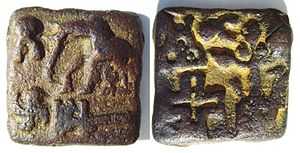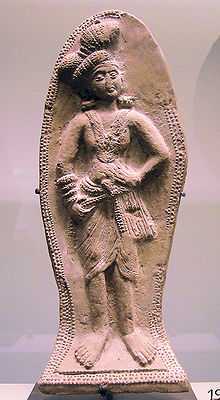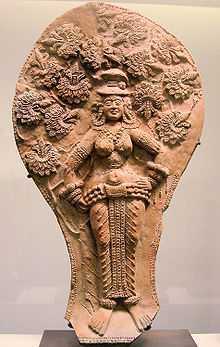Sunga Empire
| Sunga Empire शुंग राजवंश | |||||
| |||||
 Approximate extent of the Sunga empire in (c. 185 BCE). | |||||
| Capital | Pataliputra Vidisa | ||||
| Languages | Sanskrit Prakrit Pali | ||||
| Religion | Hinduism Buddhism Jainism | ||||
| Government | Monarchy | ||||
| Emperor | |||||
| - | 185–151 BCE | Pusyamitra Sunga | |||
| - | 83–75 BCE | Devabhuti | |||
| Historical era | Antiquity | ||||
| - | Established | 185 BCE | |||
| - | Disestablished | 75 BCE | |||
| Today part of | | ||||
The Sunga Empire (Sanskrit: शुंग राजवंश) or Shunga Empire was an ancient Indian dynasty from Magadha that controlled vast areas of the Indian Subcontinent from around 187 to 78 BCE. The dynasty was established by Pusyamitra Sunga, after the fall of the Maurya Empire. Its capital was Pataliputra, but later emperors such as Bhagabhadra also held court at Besnagar, modern Vidisha in Eastern Malwa.[2]
Pushyamitra Sunga ruled for 36 years and was succeeded by his son Agnimitra. There were ten Sunga rulers. The empire is noted for its numerous wars with both foreign and indigenous powers. They fought battles with the Kalingas, Satavahanas, the Indo-Greeks, and possibly the Panchalas and Mathuras.
Art, education, philosophy, and other forms of learning flowered during this period including small terracotta images, larger stone sculptures, and architectural monuments such as the Stupa at Bharhut, and the renowned Great Stupa at Sanchi. The Sunga rulers helped to establish the tradition of royal sponsorship of learning and art. The script used by the empire was a variant of Brahmi and was used to write the Sanskrit language.
The Sunga Empire played an imperative role in patronizing Indian culture at a time when some of the most important developments in Hindu thought were taking place. Patanjali's Mahabhasya was composed in this period. Artistry also progressed with the rise of the Mathura school of art. Thereafter, there was a downfall of the dynasty and Kanvas succeeded around 73 BCE.
Origins
The Sunga dynasty was established in 185 BCE, about 50 years after Ashoka's death, when the emperor Brhadratha, the last of the Mauryan rulers, was assassinated by the then commander-in-chief of the Mauryan armed forces, Pusyamitra Sunga,[3] while he was taking the Guard of Honour of his forces. Pusyamitra Sunga then ascended the throne.
Pushyamitra Sunga became the ruler of the Magadha and neighbouring territories. The empire of Pushyamitra was extended up to Narmada in the south, and controlled Jalandhar and Sialkot in the Punjab in the north-western regions, and the city of Ujjain[4] in central India. The Kabul Valley and much of the Punjab passed into the hands of the Indo-Greeks and the Deccan to the Satavahanas.
Pushyamitra died after ruling for 36 years (187–151 BCE). He was succeeded by son Agnimitra. This prince is the hero of a famous drama by one of India's greatest playwrights, Kalidasa. Agnimitra was viceroy of Vidisha when the story takes place. The power of the Sungas gradually weakened. It is said that there were ten Sunga emperors.
The Sungas were succeeded by the Kanva dynasty around 73 BCE.
|
|
Buddhism
Following the Mauryans, the first Brahmin emperor was Pusyamitra Sunga, and is believed by some historians to have persecuted Buddhists and contributed to a resurgence of Brahmanism that forced Buddhism outwards to Kashmir, Gandhara and Bactria.[5] However, there is doubt as to whether he did persecute Buddhists actively.[5]
Support given

Later Sunga emperors were seen as amenable to Buddhism and as having contributed to the building of the stupa at Bharhut.[6]
Some writers believe that Brahmanism competed in political and spiritual realm with Buddhism[5] in the Gangetic plains. Buddhism flourished in the realms of the Bactrian kings. [citation needed]
Some Indian scholars are of the opinion that the orthodox Sunga emperors were not intolerant towards Buddhism and that Buddhism prospered during the time of the Sunga emperors. The existence of Buddhism in Bengal in the Sunga period can also be inferred from a terracotta tablet that was found at Tamralipti and is on exhibit at the Asutosh Museum, University of Calcutta.
- An inscription at Bodh Gaya at the Mahabodhi Temple records the construction of the temple as follows:
- "The gift of Nagadevi the wife of Emperor Brahmamitra."
- Another inscription reads:
- "The gift of Kurangi, the mother of living sons and the wife of Emperor Indragnimitra, son of Kosiki. The gift also of Srima of the royal palace shrine.[7][8]"

Cunningham has regretted the loss of the latter part of these important records. As regards the first coping inscription, he has found traces of eleven Brahmi letters after "Kuramgiye danam", the first nine of which read "rajapasada-cetika sa". Bloch reads these nine letters as "raja-pasada-cetikasa" and translates this expression in relation to the preceding words:
- "(the gift of Kurangi, the wife of Indragnimitra and
- the mother of living sons), "to the caitya (cetika)
- of the noble temple", taking the word raja before
- pasada as an epithet on ornans, distinguishing the
- temple as a particularly large and stately building
- similar to such expressions as rajahastin 'a noble
- elephant', rajahamsa `a goose (as distinguished from
- hamsa 'a duck'), etc." Cunningham has translated the
- expression by "the royal palace, the caitya",
- suggesting that "the mention of the raja-pasada would
- seem to connect the donor with the king's family,"
- Luders doubtfully suggests "to the king's temple" as
- a rendering of "raja-pasada-cetikasa."
Wars of the Sungas
War and conflict characterized the Sunga period. They are known to have warred with the Kalingas, Satavahanas, the Indo-Greeks, and possibly the Panchalas and Mathuras.

The Sunga Empire's wars with the Indo-Greek Kingdom figure greatly in the history of this period. From around 180 BCE the Greco-Bactrian ruler Demetrius, conquered the Kabul Valley and is theorized to have advanced into the trans-Indus. The Indo Greek Menander is credited with either joining or leading a campaign to Pataliputra with other Indian rulers; however, very little is known about the exact nature and success of the campaign. The net result of these wars remains uncertain.
.jpg)
Some interpretations of the Mahabharata and Yuga Purana have attempted to account for this:
The Anushasanaparava of the Mahabharata affirms that the city of Mathura was under the joint control of the Yavanas and the Kambojas.[9]
Also the Hindu text of the Yuga Purana, which describes Indian historical events in the form of a prophecy,[10] relates the attack of the Indo-Greeks on the capital Pataliputra, a magnificent fortified city with 570 towers and 64 gates according to Megasthenes,[11] and describes the ultimate destruction of the city's walls:
- "Then, after having approached Saketa together with the Panchalas and the Mathuras, the Yavanas, valiant in battle, will reach Kusumadhvaja ("The town of the flower-standard", Pataliputra). Then, once Puspapura (another name of Pataliputra) has been reached and its celebrated mud[-walls] cast down, all the realm will be in disorder." (Yuga Purana, Paragraph 47–48, 2002 edition.)

Pushyamitra is recorded to have performed two Ashvamedha Yagnas and Sunga imperial inscriptions have extended as far as Jalandhar. Scriptures such as the Divyavadhana note that his rule extended even farther to Sialkot, in the Punjab. Moreover, if it was lost, Mathura was regained by the Sungas around 100 BCE (or by other indigenous rulers: the Arjunayanas (area of Mathura) and Yaudheyas mention military victories on their coins ("Victory of the Arjunayanas", "Victory of the Yaudheyas"), and during the 1st century BCE, the Trigartas, Audumbaras and finally the Kunindas also started to mint their own coins). Accounts of battles between the Greeks and the Sunga in Northwestern India are also found in the Mālavikāgnimitram, a play by Kālidāsa which describes a battle between Greek cavalrymen and Vasumitra, the grandson of Pushyamitra, on the Indus river, in which the Indians defeated the Greeks and Pushyamitra successfully completed the Ashvamedha Yagna.[12]
Nevertheless, very little can be said with great certainty. However, what does appear clear is that the two realms appeared to have established normalized diplomatic relations in the succeeding reigns of their respective rulers.
The Indo-Greeks and the Sungas seem to have reconciled and exchanged diplomatic missions around 110 BCE, as indicated by the Heliodorus pillar, which records the dispatch of a Greek ambassador named Heliodorus, from the court of the Indo-Greek king Antialcidas, to the court of the Sunga emperor Bhagabhadra at the site of Vidisha in central India.
Cultural contributions

While there is much debate on the religious politics of the Sunga dynasty, it is recognized for a number of contributions. Art, education, philosophy, and other learning flowered during this period. Most notably, Patanjali's Yoga Sutras and Mahabhasya were composed in this period. It is also noted for its subsequent mention in the Malavikaagnimitra. This work was composed by Kalidasa in the later Gupta period, and romanticized the love of Malavika and King Agnimitra, with a background of court intrigue.
Artistry on the subcontinent also progressed with the rise of the Mathura school, which is considered the indigenous counterpart to the more Hellenistic Gandhara school of Afghanistan and Pakistan.
During the historical Sunga period (185 to 73 BCE), Buddhist activity also managed to survive somewhat in central India (Madhya Pradesh) as suggested by some architectural expansions that were done at the stupas of Sanchi and Barhut, originally started under Emperor Ashoka. It remains uncertain whether these works were due to the weakness of the control of the Sungas in these areas, or a sign of tolerance on their part.
The last of the Sunga emperor was Devabhuti (83–73 BCE). He was assassinated by his minister (Vasudeva Kanva) and is said to have been overfond of the company of women. The Sunga dynasty was then replaced by the subsequent Kanvas.
-

Sunga Yakshi, 2nd–1st century BCE.
-

Sunga masculine figurine (molded plate). 2nd–1st century BCE.
-

Sunga woman with child. 2nd–1st century BCE.
-
Sunga Yaksa. 2nd–1st century BCE.
-

Sunga fecundity deity. 2nd–1st century BCE.
-

Sunga fecundity deity. 2nd–1st century BCE.
Script
The script used by the Sunga was a variant of Brahmi, and was used to write the Sanskrit language. The script is thought to be an intermediary between the Maurya and the Kalinga Brahmi scripts.[13]
| Outline of South Asian history History of Indian subcontinent |
|---|
|
7000–3000 BC: Stone Age
|
|
3000–1300 BC: Bronze Age
|
|
1700–26 BC: Iron Age
|
|
21–1279 AD: Middle Kingdoms
|
|
1206–1596: Late medieval age
|
|
1526–1858: Early modern period
|
|
1505–1961: Colonial period
|
|
Other states (1102–1947)
|
|
Kingdoms of Sri Lanka
|
|
Nation histories
|
|
Regional histories |
List of Sunga Emperors
- Pusyamitra Sunga (185–149 BCE)
- Agnimitra (149–141 BCE)
- Vasujyeshtha (141–131 BCE)
- Vasumitra (131–124 BCE)
- Andhraka (124–122 BCE)
- Pulindaka (122–119 BCE)
- Ghosha (?)
- Vajramitra (?)
- Bhagabhadra (?)
- Devabhuti (83–73 BCE)
| Preceded by Maurya dynasty |
Magadha dynasties | Succeeded by Kanva dynasty |
See also
| Classical India | ||||||||
|---|---|---|---|---|---|---|---|---|
| Timeline and cultural period |
Northwestern India (Punjab-Sapta Sindhu) |
Indo-Gangetic Plain | Central India | Southern India | ||||
| Western Gangetic Plain | Northern India (Central Gangetic Plain) |
Northeastern India | ||||||
| IRON AGE | ||||||||
| Culture | Late Vedic Period | Late Vedic Period (Brahmin ideology)[lower-alpha 1] |
Late Vedic Period (Kshatriya/Shramanic culture)[lower-alpha 2] |
Pre-history | ||||
| 6th century BCE | Gandhara | Kuru-Panchala | Magadha | Adivasi (tribes) | ||||
| Culture | Persian-Greek influences | "Second Urbanisation" Rise of Shramana movements |
Pre-history | |||||
| 5th century BCE | (Persian rule) | Shishunaga dynasty | Adivasi (tribes) | |||||
| 4th century BCE | (Greek conquests) |
Nanda empire |
||||||
| HISTORICAL AGE | ||||||||
| Culture | Spread of Buddhism | Pre-history | Sangam period (300 BCE – 200 CE) | |||||
| 3rd century BCE | Maurya Empire | Early Cholas Cheras 46 other small kingdoms in Ancient Thamizhagam | ||||||
| Culture | Preclassical Hinduism[lower-alpha 3] - "Hindu Synthesis"[lower-alpha 4] (ca. 200 BCE-300 CE)[lower-alpha 5][lower-alpha 6] Epics - Puranas - Ramayana - Mahabharata - Bhagavad Gita - Brahma Sutras - Smarta Tradition Mahayana Buddhism |
Sangam period (continued) | ||||||
| 2nd century BCE | Indo-Greek Kingdom | Sunga Empire | Adivasi (tribes) | Early Cholas Cheras 46 other small kingdoms in Ancient Thamizhagam | ||||
| 1st century BCE | Yona | Maha-Meghavahana Dynasty | ||||||
| 1st century CE | Kuninda Kingdom | |||||||
| 2nd century | Pahlava | Varman dynasty | ||||||
| 3rd century | Kushan Empire | Western Satraps | Kamarupa kingdom | Kalabhras dynasty Pandyan Kingdom(Under Kalabhras) | ||||
| Culture | "Golden Age of Hinduism"(ca. 320-650 CE)[lower-alpha 7] Puranas Co-existence of Hinduism and Buddhism | |||||||
| 4th century | Gupta Empire | Kalabhras dynasty Pandyan Kingdom(Under Kalabhras) Kadamba Dynasty Western Ganga Dynasty | ||||||
| 5th century | Maitraka | Adivasi (tribes) | Kalabhras dynasty Pandyan Kingdom(Under Kalabhras) | |||||
| 6th century | Kalabhras dynasty Pandyan Kingdom(Under Kalabhras) | |||||||
| Culture | Late-Classical Hinduism (ca. 650-1100 CE)[lower-alpha 8] Advaita Vedanta - Tantra Decline of Buddhism in India | |||||||
| 7th century | Indo-Sassanids | Vakataka dynasty, Harsha | Mlechchha dynasty | Adivasi (tribes) | Pandyan Kingdom(Under Kalabhras) Pandyan Kingdom(Revival) | |||
| 8th century | Kidarite Kingdom | Pandyan Kingdom Kalachuri | ||||||
| 9th century | Indo-Hephthalites (Huna) | Gurjara-Pratihara | Pandyan Kingdom Pandyan Kingdom(Under Cholas) Chera Perumals of Makkotai | |||||
| 10th century | Pala dynasty Kamboja-Pala dynasty |
Medieval Cholas Pandyan Kingdom(Under Cholas) Chera Perumals of Makkotai Rashtrakuta | ||||||
| Culture | Islamic rule and "Sects of Hinduism" (ca. 1100-1850 CE)[lower-alpha 9] - Medieval and Late Puranic Period (500–1500 CE)[lower-alpha 10] | |||||||
| 11th century | (Islamic conquests) Kabul Shahi (Islamic Empire) |
Pala Empire |
Adivasi (tribes) | Medieval Cholas Pandyan Kingdom(Under Cholas) Later Cholas Chera Perumals of Makkotai Yadava dynasty | ||||
| 12th century | Later Cholas Pandyan Kingdom(Under Cholas) Chera Perumals of Makkotai Alupa Dynasty Chera-Ai Dynasty Venadu Cheras | |||||||
| 13th century | Later Cholas Pandyan Kingdom(Under Cholas) Pandyan Kingdom(Revival) Venadu Cheras | |||||||
| 14th century | Pandyan Kingdom(Ruled from Madurai) Khilji Dynasty Pandyan Kingdom(Thenkaasi Pandiyar(Ruled from Thenkaasi after conquest)) | |||||||
| 15th century | Pandyan Kingdom(Thenkaasi Pandiyar) | |||||||
| 16th century | Pandyan Kingdom(Thenkaasi Pandiyar) | |||||||
| 17th century | Pandyan Kingdom(Thenkaasi Pandiyar) | |||||||
| ||||||||
Notes
- ↑ D.N. Jha,"Early India: A Concise History"p.150, plate 17
- ↑
- ↑ "Pusyamitra is said in the Puranas to have been the senānī or army-commander of the last Maurya emperor Brhadratha" The Yuga Purana, Mitchener, 2002.
- ↑ India :: The Shunga Empire– Britannica Online Encyclopedia
- ↑ 5.0 5.1 5.2 Sarvastivada pg 38–39
- ↑ Akira Hirakawa, Paul Groner, "A History of Indian Buddhism: From Sakyamuni to Early Mahayana", Motilal Banarsidass Publ., 1996, ISBN 81-208-0955-6 pg 223
- ↑ (Barua, B.M., 'Old Buddhist Shrines at Bodh-Gaya Inscriptions)
- ↑
- ↑ "tatha Yavana Kamboja Mathuram.abhitash cha ye./ ete ashava.yuddha.kushaladasinatyasi charminah."//5 — (MBH 12/105/5, Kumbhakonam Ed)
- ↑ "For any scholar engaged in the study of the presence of the Indo-Greeks or Indo-Scythians before the Christian Era, the Yuga Purana is an important source material" Dilip Coomer Ghose, General Secretary, The Asiatic Society, Kolkata, 2002
- ↑ "The greatest city in India is that which is called Palimbothra, in the dominions of the Prasians [...] Megasthenes informs us that this city stretched in the inhabited quarters to an extreme length on each side of eighty stadia, and that its breadth was fifteen stadia, and that a ditch encompassed it all round, which was six hundred feet in breadth and thirty cubits in depth, and that the wall was crowned with 570 towers and had four-and-sixty gates." Arr. Ind. 10. "Of Pataliputra and the Manners of the Indians.", quoting Megasthenes Text
- ↑ "Indo-Greek, Indo-Scythian and Indo-Parthian coins in the Smithsonian institution", Bopearachchi, p16. Also: "Kalidasa recounts in his Mālavikāgnimitra (5.15.14–24) that Puspamitra appointed his grandson Vasumitra to guard his sacrificial horse, which wandered on the right bank of the Sindhu river and was seized by Yavana cavalrymen- the latter being thereafter defeated by Vasumitra. The "Sindhu" referred to in this context may refer the river Indus: but such an extension of Sunga power seems unlikely, and it is more probable that it denotes one of two rivers in central India -either the Sindhu river which is a tributary of the Yamuna, or the Kali-Sindhu river which is a tributary of the Chambal." The Yuga Purana, Mitchener, 2002.
- ↑ Source
See also
History of Buddhism
History of India
Greco-Buddhism
References
- "The Legend of King Asoka, A study and translation of the Asokavadana", John Strong, Princeton Library of Asian translations, 1983, ISBN 0-691-01459-0
References
- "Dictionary of Buddhism" by Damien KEOWN (Oxford University Press, 2003) ISBN 0-19-860560-9
- "Ashoka and the decline of the Mauryas" Romila Thaper (London 1961).
- "The Yuga Purana", John E. Mitchiner, Kolkata, The Asiatic Society, 2002, ISBN 81-7236-124-6
External links
| Wikimedia Commons has media related to Sunga Empire. |


